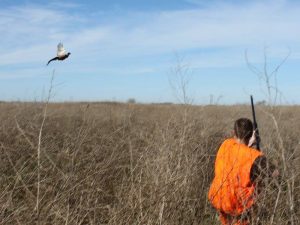Our Outdoors: Safe & Successful
By Nick Simonson
A safe hunt is a successful hunt. Every time you ascend the stand, set foot into the grass, or toss out a spread of decoys should end with a safe descent, a return to the truck and a retrieval of those ducks – both fake and real. The quarry means less than the memories of wildlife at sunrise, time with friends and family or the adrenaline of a flushing or approaching animal. Safety is something that can’t be belabored and should be second nature, but with time and the excitement of approaching seasons a refresher is always appropriate. Take that time now to review these safety tips, and recall others to make this autumn a safe and enjoyable one in the field.
On Stand
Whether with the bow or gun, deer season is the most heralded of all the hunting seasons in the upper Midwest, and it also receives the most attention for injuries and incidents in the field. While rifle season draws the most attention, due to the number of individuals out there, archery hunting presents the higher opportunity for injuries, as many hunters utilize open, elevated stands to pursue their targets. This makes the employment of fall restraints and safety harnesses a must for elevated hunters. According to recent studies, nearly 90 percent of all treestand falls could have been prevented with a harness and restraint. Additionally, having a tow rope attached to the stand is key in freeing up hands for climbing. Hook your bow, packs and other gear to it and pull it up to the seat once you’re locked in place.
For firearm hunters throughout the region, the basic rules of safe gun handling apply. Know your target and what lies beyond it before taking aim, flipping off the safety and putting your finger on the trigger. Think twice, shoot once. When the shot has been taken, put the safety back on; it may be tough to override the adrenaline of the moment but securing the safety mechanism is of the utmost importance, especially on semi-automatic firearms.
 In the Field
In the Field
When headed out for upland game, be aware of your surroundings and the members in your party, including the four-legged ones. Flushing grouse or pheasants can again trigger a rush of excitement, but don’t let it overpower your safety skills. Line up the shot, know how far left or right you can follow the bird with your shotgun, and where the next person is in your group of hunters. Keep shots elevated, so as to not risk injuring the hard-working dogs in front of you and avoid “ground pounding” birds.
When approaching and crossing obstacles like fences or small creeks, make sure to have the safety mechanism on and open the breach or action as well to prevent any jarring or accidental misfires. When hunting with others, take turns crossing and hand firearms over the obstruction, confirming verbally that they have control of the gun before releasing it. Check the safety status before setting off again, once everyone is ready.
On the Water
As autumn air cools sloughs, rivers and lakes, the same risks of early spring fishing are present for waterfowl hunters who choose to hunt from a boat, canoe or kayak. Wearing a life jacket helps with buoyancy and will keep you afloat when cold waters trigger a rapid exhaling of air from the lungs due to the shock of the cold temperatures. With a variety of comfortable mesh-shouldered options in camo patterns, wearing one has never been easier or more in line with the pursuit of waterfowling.
As with all the above activities, letting someone at home know where you’re headed, be it a spouse a neighbor or a friend, in as much detail as possible, is a good idea every time you go hunting. Make it a point to provide a quick note with reference to the hunting locations and areas you will park at, to make locating you easier should something unforeseen occur. Provide a timetable for your hunt and utilize a cell phone to check in as needed or scheduled.
These are just a few safety reminders to help make this autumn’s hunting season more successful. Review tips from the International Hunters Education Association (http://www.ihea-usa.org) for more information on how to stay safe in the field and make every trip a good one…in our outdoors.
